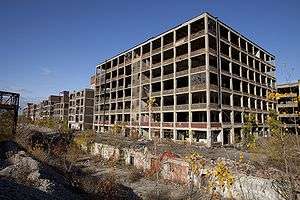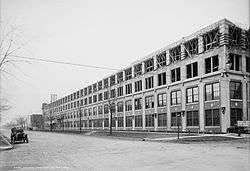Packard Automotive Plant
| Packard Automotive Plant | |
|---|---|
 The Packard Automotive Plant in 2009 | |
| General information | |
| Status | Undergoing cleanup, renovations and reconstruction |
| Type | Automobile factory |
| Location | Detroit, Michigan, U.S. |
| Coordinates | 42°22′46.62″N 83°1′44.14″W / 42.3796167°N 83.0289278°WCoordinates: 42°22′46.62″N 83°1′44.14″W / 42.3796167°N 83.0289278°W |
| Construction started | 1903 |
| Completed | 1911 |
| Technical details | |
| Floor area | 3,500,000 sq ft (330,000 m2) |
| Design and construction | |
| Architect | Albert Kahn |
| Structural engineer | Henry Joy |
The Packard Automotive Plant is a former automobile-manufacturing factory in Detroit, Michigan where luxury cars were made by the Packard Motor Car Company and later by the Studebaker-Packard Corporation.
Design and operation

The 3,500,000-square-foot (325,000 m2), plant was designed by Albert Kahn Associates using Trussed Concrete Steel Company products. It is located on 40 acres (16 ha) of land on East Grand Boulevard on the city's east side. It included the first use of reinforced concrete in the United States for industrial construction in the automobile industry.[1][2][3][4][5]
The Packard plant was opened in 1903 and at the time was considered the most modern automobile manufacturing facility in the world, with skilled craftsmen involved in over eighty trades. The factory complex closed in 1958, though other businesses operated on the premises or used it for storage until the late 1990s.
In the 1990s, the buildings were used to host infamous "underground" raves and techno parties, including the Spastik party hosted by Richie Hawtin [6][7]
A number of the outer buildings were in use by businesses up through the early 2000s. In 2010, the last remaining tenant, Chemical Processing, announced its intention to vacate the premises after 52 years.[8]
Current status

Since its abandonment, the plant has been a haven for graffiti artists, urban explorers, paintballers and auto scrappers, and much of the wiring and other building materials have been scavenged.[9] In one incident, vandals pushed a dump truck from the fourth floor. Karen Nagher, the executive director of the nonprofit organization Preservation Wayne, stated that she was irked to see people come from "all over the world" to poke around Detroit. "Piece by piece, they're disassembling those buildings, making it harder and harder to restore them".[10]
Despite many years of neglect and abuse, the reinforced concrete structures remain mostly intact and structurally sound. Portions of the upper floors of several small sections in various buildings have collapsed or been partly demolished and lie in ruins in the wake of several aborted attempts at demolition over the years.
The City of Detroit has pledged legal action to have the property demolished or secured.[11] Dominic Cristini, whose claim of ownership is disputed, was said to be conducting construction surveys in advance of full-scale demolition as of early 2012.[12][13]
On February 5, 2013, it was reported that aluminum letter placards spelling the Nazi slogan "Arbeit macht frei" (work makes free) were placed in the windows of the E. Grand Boulevard bridge.[14][15] Community volunteers promptly removed the letters.
In April 2013, it was announced that AMC's Low Winter Sun would be filming around the location.[16]
Sale
Due to tax delinquency, the 43 parcels composing the plant were put up for auction in September 2013. The starting bid was $975,000 (the amount owed in taxes) and there were no takers.[17]
Another auction in October 2013 posted a starting bid of $21,000, or about $500 per parcel.[18] This auction closed with a top bid of $6,038,000 by Dr. Jill Van Horn, a Texas-based physician who announced in an email that she would team up with "partners and investors from Detroit, Wall Street and international firms," to turn the site into an "economic engine", refurbishing the plant grounds for a manufactured-house assembly facility.[19] However, the deadline for full payment was missed, prompting Wayne County to initiate talks with the second-highest bidder, Bill Hults, a Chicago-area developer who placed a $2,003,000 bid in the October auction. In a separate email, Dr. Van Horn stated, "It seemed (David Szymanski, Deputy Wayne County Treasurer) had already made up his mind to talk to the second bidder". Hults then made several non-refundable down-payments on the plant, but he ultimately failed to raise the entire sum of his bid.
Around the same time in October 2013, a Spanish investor, Fernando Palazuelo, also expressed interest in securing the Packard Plant. It was purchased for $405,000 on December 12, 2013.[20][21] Palazuelo plans on moving into the plant by April 9, his 59th birthday. He plans on having six different uses for the Packard Plant Project (residential, retail, offices, light industry, recreation and art) that is estimated to cost about $350 million over the next 10 to 15 years. First, he hopes to bring a big 3 automotive parts manufacturer to the plant in exchange for a few years of free rent. He also hopes to create a work space for local artists and an upscale go-kart track.[22]
As of August 2016, no redevelopment had taken place at the historic 40-acre site on Detroit's east side. At the time, many remained skeptical that the enormous effort would ever succeed — or even get off the ground — given the nearly half-billion-dollar price tag of the project that Palazuelo had envisioned.[23]
Renovation
In May 2017, Arte Express, the holding company for Palazuelo, held a ground breaking ceremony for phase I of the project which will include the former 121,000-square-foot administrative building on the site.[24] On August 12, 2017, the inaugural public tour of the property was conducted, which included access to the second floor of the administration building on the complex's western side.[25] It is predicted that office space in the administration building could become available as early as 2019.[25]
See also
References
- ↑ Olsen 2002, p. 38 "In 1905 Kahn and Julius designed the Packard Plant number 10 using steel-reinforced concrete, the first such application for an industrial plant".
- ↑ Smith 1994, p. 59 "Together they built ten works buildings for Packard, Plant No. 10 (1905) being the first reinforced concrete structure in the automobile industry, notable for its lengths of open space between columns and the good lighting from near-floor-to-ceiling windows".
- ↑ Darley 2003, p. 82 "The example of flexibility that he chose to illustrate was Albert Kahn's building of 1905 for Packard in Detroit, building No. 10, the first to use the Kahn reinforced concrete system successfully, which has been effortlessly extended by an additional two stories in 1911".
- ↑ Baldwin 2002, p. 197 "His first major corporate client was the Packard Motor Car Company, headed by Henry B. Joy, from whom Kahn eventually designed ten buildings, culminating in Detroit's first large auto plant, the first reinforced concrete auto factory in America".
- ↑ Sedlar, Frank (June 24, 2013). "Engineering Industrial Architecture: Albert Kahn and the Trussed Concrete Steel Company" (PDF). 2012–2013 MLibrary Undergraduate Research Award Maize Award for Single-Term Projects. University of Michigan.
- ↑ "Even in ruin, Detroit's Packard plant inspires artists".
- ↑ "Five More Unbelievable Places Richie Hawtin Has Played". November 20, 2013.
- ↑
- ↑
- ↑ Kellogg, Alex P. (November 6, 2009). "How Do You Put the Dump Into Dump Truck? Push It Off the Fourth Floor" – via www.wsj.com.
- ↑ "Detroit still hunting down Packard plant owner".
- ↑
- ↑ "Detroit's infamous Packard plant to be razed. Finally".
- ↑ "Packard Plant Tagged With Nazi Slogan 'Arbeit Macht Frei'". February 5, 2013.
- ↑
- ↑ Hinds, Julie (April 22, 2013). "Detroit filming for AMC's 'Low Winter Sun' will put spotlight on city". Detroit Free Press. Retrieved June 15, 2013.
- ↑ Anglebrandt, Gary (May 28, 2013). "Packard plant among parcels up for auction of foreclosed properties". Crain's Business Detroit. Retrieved June 7, 2013.
- ↑ Left Lane News. "Packard Plant headed for auction with $21,000 bid". Left Lane News. Retrieved 4 October 2013.
- ↑ "Detroit's iconic Packard plant could soon be back in business".
- ↑
- ↑
- ↑
- ↑ "Packard Plant redevelopment could actually happen soon".
- ↑ Chambers, Jennifer. "Packard Plant makeover finally springs into action". The Detroit News. Retrieved 16 August 2017.
- 1 2 Nagl, Kurt (August 12, 2017). "Inaugural Tour of Packard Plant Captivates Visitors". Crain's Detroit Business. Archived from the original on September 5, 2017. Retrieved September 24, 2017.
Bibliography
- Baldwin, Neil (2002). Henry Ford and the Jews: The Mass Production of Hate. Public Affairs. ISBN 978-1-58648-163-6.
- Darley, Gillian (2003). Factory. Reaktion Books. ISBN 978-1-86189-155-6.
- Olsen, Byron (2002). The American Auto Factory. MotorBooks International. ISBN 978-0-7603-1059-5.
- Smith, Terry (1994). Making the Modern: Industry, Art, and Design in America. University of Chicago Press. ISBN 978-0-226-76347-7.
External links
| Wikimedia Commons has media related to Packard Automotive Plant. |
- "Largest Abandoned Factory in the World: The Packard Factory, Detroit." Sometimes Interesting. 15 Aug 2011
- Detroit News
- The Abandoned Packard Plant at Detroiturbex.com
- Packard Plant photos
- blog.hemmings.com on Planned demolition mid-2012
- Recent photos of the Packard Plant
- Detroit Free Press photos - then and now
- Packard images in IR
